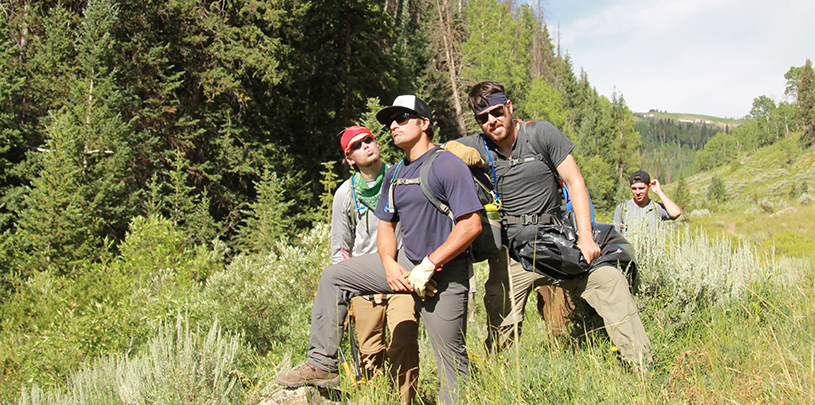
 by Lisa Winters, Research and Stewardship Volunteer Coordinator
by Lisa Winters, Research and Stewardship Volunteer Coordinator
In a little corner of Fishlake National Forest, the trash talk is flying:
“We got 243!”
“That’s all? We’re at like, 600!”
To the casual passerby, this may seem like an intense competition. In fact, it is. Fenced into a 15-acre plot within the world-famous Pando Aspen Clone, 15 tough young men, some with tattoos and others with pants dragging a little low, are pulling weeds. Decked out in bandanas and clipboards, and wielding trowels, we’re on a mission to “seek and destroy” an invasive plant called houndstongue.
Since 2014, the Grand Canyon Trust has been working in the Pando Clone alongside the U.S. Forest Service, grazing permittees, scientists, and others to restore ecosystem health of the aspen forest. The plot is a unique research opportunity to see what happens when cows are kept off the land (called a reference area). It turns out, young aspen shoot up everywhere, fragile native grasses burst forth from the ground, and native elk weed grows tall and blooms brilliantly. The ungrazed land we are weeding looks lush and dense compared to the grazed land outside the fence. The point of this Grand Canyon Trust volunteer trip is to keep it that way (the trip is aptly named “Weeding with a Purpose”). We are tracking how many invasive houndstongue we remove, with the hope that by keeping invasive species at bay, we’ll make room for native plant diversity.
The tough young men volunteering with us are from Back2Basics Outdoor Adventure Recovery, a six-month residential program that combines substance and alcohol addiction treatment with experiential outdoor adventures. Kelly McGrath, their outdoor program director, hopes that by spending time in the wilderness, being physically challenged, and clearing the mind, new healthy living patterns will begin to take shape in the young men. The group works hard in the forests and canyons of the Southwest every week and is excited to give back to the land.
After the excitement of picking over 8,000 houndstongue (I kid you not – I heard “so stoked!” many times), we head off to battle the next invasive species, the musk thistle, at Huntington Creek.
“Who has a trash bag?” a young man asks.
“Oh my gosh, that thistle is taller than you!” another exclaims.

We don gloves and attack the thorny musk thistle ferociously for two days. Here at the Huntington Creek reference area, where sheep have been kept out for more than 10 years, we work quickly to remove the threat of thistle. Toward the end of the day, we also find time for a quick hike through a canyon the young men describe as like “something out of National Geographic.” After a long day of work, it’s nice to be able to enjoy the public lands we’re working so hard to protect.
We stop early the next day as ominous black clouds, roaring thunder, and electric lightning quickly move in. It’s a reminder that we are perched on the top of a ridgeline at 10,000 feet in elevation. I gather my thoughts, and the ingredients for green chili stew, as the group holds an Alcoholics Anonymous meeting in their van before dinner.
While not a typical volunteer trip for the Grand Canyon Trust, I get the sense that everyone has learned something this week. We chat with an employee of the Forest Service, which manages grazing in the area, who describes the challenges of working with both advocacy groups like the Trust and ranchers who use the land for their livestock. After the conversation, a couple volunteers ask me about going to school for forestry or botany, and getting a job in those fields. Others reflect on the trip saying, “I want to do more work like this and find a job that relates to these conservation issues,” and “[The trip] inspired me to continue participating with the Trust and to pursue an education and career in this field.”
By the end of the week, we’ve removed over 9,000 houndstongue and 4,000 musk thistle. While the competition between trip participants was intense, I think the real winner of this competition is our public lands.
The federal government will determine if the charismatic blue bird should be listed as threatened or endangered.
Read MoreWe can’t wait to meet you in a canyon, along a creek, or in the high alpine meadows of the Colorado Plateau.
Read MorePronghorn and barbed wire fences don't mix, but volunteers are working to change that, one wire at a time.
Read More